Beginning in 2011, the first members of the baby boom generation turned 65 and started entering the Medicare program in large numbers.
The assumption was that this large volume of comparably younger and healthier beneficiaries would slow the growth of per-beneficiary spending in Medicare, which at the time was already at historically low growth levels.
In a new data brief published Dec. 27, 2019 by The Commonwealth Fund, Vanderbilt University Medical Center Assistant Professor Laura Keohane, Ph.D., and Melinda Buntin, Ph.D., Mike Curb Professor of Health Policy and Chair, Department of Health Policy, find that even if there were no influx of new beneficiaries, spending growth would have remained low.
“This shift toward a younger Medicare population, however, explains very little of why Medicare per-beneficiary spending growth was low from 2007 to 2015,” Keohane wrote in the brief.
Lucas Stewart, former VUMC health policy analyst, also co-wrote the brief.
One of the primary findings is that with the increase in beneficiaries aged 65-69, spending levels per beneficiary only slightly lowered between 2007 and 2015. Average spending levels reduced from $8,829 per beneficiary in 2007 to $8,794 per beneficiary in 2015, a change of $35.
Read the full data brief at The Commonwealth Fund website.
